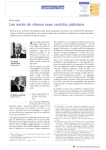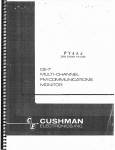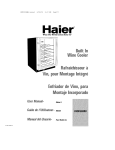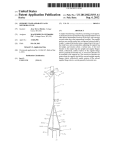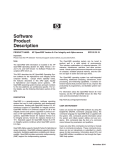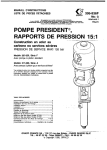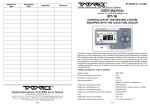Download ESS Performance series Specifications
Transcript
lighi
Perf()rmance
5erie§
OWNERS MANUAL
CONTENTS
INTRODUCTION
............................. . CONNECTING YOUR SPEAKERS ....... .. . ... . • Phasing
SPEAKER PLACEMENT ........................ 3 COMPONENTS ................................ 3 • Midrange/High Frequency
• Low Frequency Driver
• The Passive Radiator
• Frequency Dividing Network . ............ 4 SPECIFICATIONS ..............
THE I:vlPORTANCE OF ''CLEAN'' AMPLIFIER OUTPUT ........
. ........... 6 MULTIPLE SPEAKER CONNECTION ............. 6 HElL ROTATION FOR HORIZONTAL PLACEMENT CABINET CARE
. . . . . . . . . . . . . . . . . . . . . . .. 7 SERVICE ..................................... 7 LIMITED 3-YEAR WARRANTY .................. 8 page 1
MODEL 4,5,8 CONNECTING YOUR SPEAKERS
I
l
I
INTRODUCTION
ESS Perfonnance Series speakers are among the most effi
cient Reil air- motion transformer loudspeakers available; all
feature a 10" passive radiator tuned to optimize the bass
response in their respective system; all speakers provide the
tonal clarity characteristic ofHeil air-motion transformersys
terns; all are superb instruments meant to last a lifetime with
proper care. We urge you to read this Owner's Manual care
fully. It will familiarize you with speaker connection proce
dures and placement options. The manual also includes
background material on the ESS Perfonnance Series compo
nents and their characteristics. We hope that this information
and the pleasure you derive from your new speaker system
will meet and exceed your expectations.
Follow the steps below to ensure that your ESS Perfonnance
Series speakers are properly connected to your electronics.
Connecting the speakers will be easy. However, because
minor errors in the connection procedure can diminish the
perfonnance of your speakers and electronics, we urge you to
follow these directions carefully:
• Turn your electronics off while connecting the speakers to
avoid any possibility of damage by shorting.
• If you plan to drive more than one pair of speakers simul
taneously with your stereo receiver, or if you plan to drive
more than four speakers with a 4-channel unit, turn to
"Multiple Speaker Connection."
• You were probably' supplied with wire to connect the
speakers to your electronics at the time of purchase. We
recommend 18-gauge lamp cord (commonly called "zip"
cord) if the speaker will be 25 feet (7.5 m) or less from
your electronics. Use of thinner wire (larger gauge
number) than 18 gauge is not recommended under any
circumstances; 16 gauge cord is strongly recommended for
speaker placement in excess of 25 feet from your elec
tronics.
page 2
• The "Left" and "Right" designations on the speaker out
put terminals of your amplifier or receiver refer to the
speakers as you face them. Thus the Left Channel output of
your receiver should be connected to the speaker on your
left, and the Right Channel output from the receiver should
be connected to the speaker on your right.
It is very important that the positive (" +") and
(" ") posts of your electronics connect properly to
responding speaker posts.
All double-strand wires are coded to ensure that ground
(" -") and positive (" +") wire can be identified throughout
the length of the cord. Examination of solid-colored cord will
reveal one or more ridges along one side of the insulation. It
is standard to connect the rigid side to the negative (BLACK)
terminal. The wire with smooth insulation should connect to
the positive (RED) terminal at the amplifier and to the posi
tive terminal on the corresponding speakcr. Cords with clear
plastic insulation generally have wire of two different colors
for identification
usually copper and silver. Copper cOO
nects to the negative terminal, silver to the positive terminal.
INPUT TERMINAL CONNECTION
• The ternimal posts at the rear of your ESS Performance
Series speakers require that you strip about 1;4 II (7 mm) of
insulation off the end of the connecting wire. The connec
tion to your amplifier or recei ver will probably also require
that the wire be similarly stripped for a short length. KO
PORTION OF THE STRIPPED CONNECTING WIRE
AT THE SPEAKER OR AMPLIFIER TERMINALS
SHOULD TOUCH THE OTHER WIRE. Shorting of
speaker leads at the speaker or amplifier can damage your
equipment. Be sure that the wires at your amplifier and
speakers are properly isolated.
• Press the spring-loaded clamp at the terminal posts of the
speakers to insert the stripped wire into the terminal. Re
lease the clamp to lock the connecting wire firmly to the
terminal post. Once the leads are connected from elec
tronics to speakers, your system should be ready to tum
on.
PHASING: If your speakers seem to image poorly or if the
bass seems inadequate, it is possible that they have inadver
tently been connected OUT OF PHASE. To check for proper
phasing, follow this procedure:
• Switch your receiver or preamplifier to the MONO mode.
Select a program source and position yourself equidis
tantly in front of the speakers. If the sound seems to ema
nate clearly from betwecn the two speakers, they are prop
erly phased. However, if you hear a broad vague sound
which leaps from side to side as you move your head off
center, your speakers are out of phase. The problem can
easily be corrected by reversing the connection to ONE of
the speakers. Switching to stereo should reveal the drama
tic, natural sound that you have come to expect of proper
stereo imaging.
page 3
SPEAKER PLACEMENT
A speaker's room placement and its orientation to the listener
can have a major bearing on the quality of sound you hear.
The proper functioning of the passive radiator at the rear of
the model 5 & 8 requires that these speakers be placed no
closer than one inch from the wall. Maximum bass perfor
mance will probably occur with the speaker placed 3 to 5
inches from the wall. Because the passive radiator is located
in the front of the model 4, that speaker may be placed diagainst a rear wall. Aside from not placing the models
5 or 8 directly against the rear wall, you will probably want to
experiment with room placement if your room and furnish
ings do not limit placement possibilities.
Generally, optimal stereo imaging is obtained by placing both
speakers along one plane, parallel to each other about five to
eight feet apart. If the speaker is a bookshelf configuration,
placing the speakers on the floor, near comers, will aug.ment
bass response but might tend to make the bass "overpower"
the rest of the speaker. If the bass seems excessive, try mov
ing the speaker away from the corner or try elevating the
speakers a few inches off the tloor.
The furnishings in your room can also importantly affect how
your speakers sound. Large windows, paneled walls and
wooden floor and/or ceilings are characteristic of "live"
rooms. Ideally, highly retlective surfaces are acoustically
optimized by opposite absorptive surfaces. Heavily draped,
upholstered and carpeted rooms lacking any retlective sur
faces tend to be acoustically non-reverberant or "dead".
Rooms with a balance between reflective surfaces tend to be
most acoustically ideal. If possible, experiment with speaker
and decor placement to obtain a sound quality that you find
pleasing.
COMPONENTS
MIDRANGE/HIGH FREQUENCY:
The Heil Air-Motion Transformer
Unlike the Performance Series Heil driver, conventional
midrange and high frequency drivers are highly susceptible
to diaphragm resonance. When a cone, for instance, is driven
at certain frequencies, it begins to change shape "in sym
pathy" with the drive frequency. This vibration, known as
diaphragm resonance, absorbs energy, blunting transient at
tack and causing overhang. Moreover, when another signal is
introduced at the same time the resonating diaphragm tight
ens up, like a rubber band stretched between two points. This
forces the resonating frequency to rise in frequency. This
change in frequency is a major factor in "masking" clarity
due to pitch variation.
One way to avoid resonance is to make the diaphragm abso
lutely rigid. Unfortunately, this.entails making the diaphragm
massive and difficult to drive.
A more effeetive way to avoid resonance is found in the
concept of distributed drive. When a driving force is distri
buted uniformly over a diaphragm's moving surface area, it
supports the diaphragm; the diaphragm is thereby effectively
made rigid without extra weight. Resonant vibrations simply
do not occur.
The diaphragm of the Heil air-motion transformer incorpo
rates both concepts. Its surface area is folded into deep verti
cal pleats. Conductive aluminum strips bonded to the pleat
walls move with the electronic signal, causing the pleats to
close or open along their entire length.
As the pleats expand or contract, air is sucked in or forced out
the open end. The pleat walls move only one fifth as far as the
escaping air, thus reducing the possibility of flexing. The
air-motion transformation ratio is thus 5 to 1.
The Heil's pleat action has two major advantages over con
ventional methods. First, it eliminates the possibility of dia
phragm resonance. Since the Heil's pleat walls are totally
drive-supported by the aluminum strips, they cannot bend out
of shape to go into resonance. Second, when the Heil's deep
pleats force the air out, they move the air much farther- and
faster than they themselves move creating a large, high
velocity air motion from a short,
diaphragm move
ment.
This is important because it drastically reduces the effeetive
moving mass of the diaphragm. The Heil builds up only a
fraction of the momentum generated by conventional one
to-one drivers, transferring energy to the air efficiently at all
frequencies.
The Heil transformer's pleated configuration has the added
advantage of spectacular dispersion by virtue of its small
radiating source. Conventional speakers reproducing similar
frequencies are usually so wide by comparison that sound
waves from one side of the disphragm interfere with waves
on the other side, narrowing the speaker's clean output to a
constricted central beam. This makes speaker placement ex
tremely critical. The Hei! air-motion transformer avoids this
side cancellation because of its compact configuration. With
a 120" horizontal pattern of 20,000 Hz, the Heil maintains a
solid expanse of stereo imagery to frequencies beyond audi
bility. A spacious sound stage can be enjoyed from virtually
any point in the listening field.
Definitive clarity, freedom from resonance, and full-range
sound dispersion
the inherent benefits of superior design.
For conventional speakers, they remain problematic goals.
page 4
LOW FREQCENCY DRIVER
THE PASSIVE RADIATOR
Different low frequency transducers are used in ESS Perfor
mance Series speakers to complement cabinet size and the
Heil air-motion transformer. Each woofer utilizes a magnetic
circuit that critically damps the drivers moving assembly and
makes possible a flat frequency response over an extended
range. The model 4 woofer operated from 35 Hz to the cross
over point at 2400 Hz into the Heil amt. The range of the
slightly less massive model 5 and 8 bass drivers operate from
40 Hz and 50 Hz respectively to the crossover point of 2400
Hz.
The 10" passive radiator on your ESS Performance Series
speaker is driven by the motional energy of the woofer. The
passive radiator works in the same way as a port except that
the velocity of the passive diaphragm is much lower than that
of the air moving through a typical port. As a result, low
frequency distortion is lower when using a passive radiator
system than when using a ported system. In order to have the
same performance from a vent, the port would have to oc
cupy the entire volume of a typical bookshelf system! Addi
tionally, the passive radiator keeps the back radiation of the
woofer where it belongs: in a tuned system within the box.
SPECIFICATIONS
FULL SYSTEM
MODEL 4
Power Capacity
Nominal Impedance
Dispersion
Crossover Frequency
Efficiency
160 Watts (clean power)
6 Ohms
1200 horizontal, 40° vertical
2400 Hz
1 Watt input produces a 96 dB of
sound pressure at a distance of
3 feet, 82 dB at 15 feet
35 Hz to 24 kHz ± 3 dB
Amplitude-Frequency Response
HElL AIR-MOTION TRANSFORMER
Total Radiating Area
Transformation Ratio
Magnet Assembly Weight
Flux Density
Square Wave Rise Time
10.4 sq. in. (67.1 cm 2 )
5.3 to 1
21;4 Ibs. (1.02 kg)
6,000 Gauss
15 Microseconds
5 kHz
LOW FREQUENCY DRIVER
Nominal Diameter
Flux Density
10 inches (25.40 cm)
11,800 Gauss
PASSIVE RADIATOR
Nominal Diameter
10 inches (25.40 cm)
DECOR
Finish
Grille Color
Dimensions
Vinyl (Walnut)
Dark Brown
35 x 12% x 12Vs in. (88.9 x
31.75 x 30.8 COl)
WEIGHT
(Including Packing)
48 lbs. (22 kg)
page 5
NOTE: In the model 5 and 8 speaker systems you can tune
your passive radiator to a lower frequency by mov
ing the rear of the speaker enclosure closer w the
wall. Maximum bass performance will probably
occur with the speaker placed 3 to 5 inches from the
wall.
Under no circumstances, should the passive
radiator be put closer than one inch from the l,vall;
since it will reduce its effectiveness dramatically,
and may result in the passive radiator's hitting the
wall when making its most extreme excursions,
FREQUENCY DIVIDING NETWORK
Optimal performance of the drivers used in your ESS Per
formance Series
is assured by a sophisticated 18dB
per octive crossover. Rugged, highest quality components
integrate the woofer and the Heil air-motion transformer at a
crossover point of 2400 Hz and provide absolute freedom
from phase interference in the midrange,
MODEL 5 MODEL 8
140 Watts (clean power)
6 Ohms
120° horizontal, 40° vertical
2400 Hz
1 Watt input produces a 95 dB of
sound pressure at a distance of
3 feet. 81 dB at 15 feet
40 Hz to 20 kHz
3 dB
100 Watts (clean power)
6 Ohms
1200 horizontal, 40° vertical
2400 Hz
1 Watt input produces 94 dB of
sound pressure at a distance of
3 feet, 80 dB at 15 feet
50 Hz to 20 kHz ± 3 dB
10.4 sq, in, (67,1 cmZ)
5,3 to 1
2% Ibs, (1.02 kg)
6,000 Gauss
15 :vficroseconds @ 5 kHz
10.4 sq, in, (67,1 cmZ)
5,3 to 1
2',4 Ibs, (1.02
6,000 Gauss
15 Microseconds @ 5 kHz
10 inches (25.40 em)
9,500 Gauss
8 inches (20.3 cm)
9,000 Gauss)
10 inches (25.40 cm) 10 inches (25.40 em)
Vinyl (Walnut)
Dark Brown
24% x 14 x 14 in, (61.3 x
35,6 x 35,6 cm)
Vinyl (Walnut) Dark Brown 22 x 12% x 10% in, (55.9 x 31.1 x 27 cm) 36 lbs. (17 kg) 30 Ibs, (14 kg)
page 6
THE IMPORTANCE OF "CLEAN"
AMPLIFIER POWER OUTPUT
MULTIPLE SPEAKER
CONNECTION
The power rating on your ESS Performance Series
loudspeaker represents the maximum amount of clean power
which the loudspeaker will handle indefinitely.
ESS Performance Series speakers have an impedance of 6
ohms. Most receivers and basic amplifiers have no difficulty
whatsoever with impedance loads above 4 ohms, but can
develop problems if the load drops below 4 ohms. Connect
ing an additional set of speakers to your Tempest will proba
bly drop the system impedance below 4 ohms; consequently,
they should not be connected in parallel. If you own a re
ceiver, driving your speakers in the A & B mode with another
set of speakers might drop the system impedance below the 4
ohm level.
A second set of speakers may be connected IN SERIES.
Series connection keeps the system impedance above 4
ohms, assuring that your electronics will handle the load
properly. Your dealer can help to clarify and answer any
questions you may have about multiple connections to your
",..______ ". Switching boxes are also available which simplify
series connection; your dealer can help you obtain such a
box. The basic series connection is diagrammed below and
should be used if you plan to connect another set of speakers
to your ESS Performance Series speakers.
Typical recorded music has peaks about lOdB higher than the
average level of the music - unless clipping is allowed to
occur. Once clipping begins three bad things happen:
I) Low frequency energy intended for the woofer is con
verted to high frequency energy which ends up in the
tweeter.
2) The average power increases without increasing the
peak power.
3) The level of distortion increases dramatically.
An amplifier in light to moderate clipping delivers as much
power as an amplifier with 25 to 50 percent greater power
output not driven into clipping.
All ESS Professional Series loudspeakers are tested with
clean power exceeding the rating of the speaker. Be assured
of your
then that if your amplifier is within the power
speaker and distortion is occurring it is your amplifier that is
being overdriven 110t your speaker.
Amplifier power ratings are typically based on an 8 ohm
impedance. Typically an amplifier will deliver 25% more
power to a 6 ohm spea~er and about 50% more power to a 4
ohm speaker. Please check the impedance rating on your
speaker in the "Specifications" section to determine the
actual power capability of the amplifier you will be
with the speakers.
As a general rule. most popular receivers will clip at about" I
o'clock" on the volume control playing into an ESS Perfor
mance Series speaker system. If your amplifier or receiver
has power output meters, it is not advisable to exceed meter
readings of 0 Vu.
Driving the loudspeakers with sine wave signals at high dB
output levels is not advisable. Driver failure from excessive
input levels, faulty electronic equipment, or owner
will not be covered under the conditions of the warranty.
Csed properly, the rugged, reliable components in your ESS
Performance Series speaker system should provide a lifetime
of outstanding service.
~I
AMPLIFIER
~[J
SYSTEM A
+~
--u
SYSTEM B
I"~ G+
~+
~--
SERIES SPEAKER CONNECTION
Connections of additional speakers to a basic 4-channel con
figuration will also require connection IN SERIES. You may
use the diagram above as a model for this procedure. If you
have a question, it is wise to contact your dealer or the man
ufacturer of your 4-channel receiver.
Once you understand the ramifications and procedure of con
necting multiple speakers, return to "Connecting Your
Speakers."
page 7
HElL ROTATION FOR
HORIZONTAL PLACEMENT
The Heil air-motion transformer in your ESS Performance
Series speaker is mounted for optimal performance in the
upright, vertical position. If you plan to lay your model 5 or 8
speake,rs on their longest side in the horizontal "bookshelf"
position, then the Heil amt may be rotated 90° in the follow
ing manner to optimize dispersion.
• Place the speaker on its back. Remove the grille from its
fasteners by gently pulling the top and bottom of the grille
upward, away from the fasteners on the front of the
speaker.
• The air-motion transformer is attached to the front mountpanel of the speaker by four screws. Remove the
screws and rotate the Heil amt assembly 90°. RefastGn the
transformer with the four screws and carefully reattach the
grille.
Your ESS Performance Series dealer should be most willing
to rotate the amt or provide further instructions if you feel
reluctant to undertake the rotation procedure.
CABINET CARE
Your ESS Performance Series loudspeakers require no more
care than that normally given fine furniture. The beauty of the
vinyl surface may be retained and enhanced with a vinyl
treatment like" Armora!. " Silicone dusting sprays and strong
abrasive compounds should not be used on the vinyl surface
of the speaker.
SERVICE
The dealership where you purchased your ESS Performance
Series speakers can best verify any complaint you may have
and can arrange for any necessary servicing.
If your dealer cannot be contacted, please write ESS, Inc.
Attention: Customer Services, and include the following in
formation:
• The model and serial number of your speakers .
• The dealer from whom your speaker was purchased, the
date of purchase, and, if possible, your phone number.
• A specific description of the problem.
• Associated equipment (including RMS power ratings of
your amp) used with the speakers.
If ESS deems return to the factory necessary, please ship
freight prepaid and be sure to use the "Authorized Return"
labels which ESS will provide. Once repaired, your unit will
be returned freight prepaid.
page 8
LIMITED THREE-YEAR
WARRANTY
When ESS Performance Speakers are used in accordance
with the written instructions contained in the Owner's Man
ual, ESS will repair any defect in workmanship and materials
that occurs in normal use for a period of 36 months from the
date of original purchase without charge for parts or labor.
The warranty applies only to the original owner and is con
tingent upon purchase from an authorized dealer, except
where prohibited by law. The owner's responsibilities are to
provide proof of purchase and transportation to the ESS fac
tory authorized service facility in the event that repair is
required.
If your speakers are removed from the country of original
purchase, ESS Performance Series distributors and/or au
thorized dealers in any subsequent country are not obligated
by the terms of this warranty. Any repairs under the terms of
this warranty will tie made at the discretion of the distributor
or dealer.
This warranty is void if the serial numbers have been re
moved or defaced, or if repair has been attempted by any
unauthorized person or agency. In addition the warranty does
not cover tampering, abuse or accidental damage. The right
is further reserved to re-adjust prices or design patameters
and specifications without notice and without incurring re
sponsibility to modity previously purchased systems. ESS
specifically excludes from this warranty any responsibility
for consequential damage.
Retention of your ORIGINAL BILL OF SALE is required to
obtain service under the terms of the warranty. Any card or
other form of registration does not constitute proof of pur
chase and will not be regarded as such. During the three year
warranty period, only presentation of your ORIGINAL BILL
OF SALE to either an authorized warranty station or the
factory itself will insure your rights under the warranty policy
described above.
IMPORTANT
ESS is constantly researching new materials, production
methods and design refinements which may be introduced
into
product lines without notice or obligation. For
this reason, any current ESS Performance Series product may
differ in some respect from its published description but will
always equal or exceed perfonnance of the original design.
;:'),inc.
9613 00 tes drIVe· sacramento, ca. 95827
LITHOGRAPHED IN US.f>..













